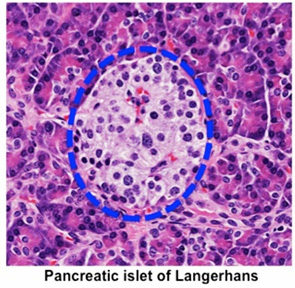|
Endocrine Pancreas, Islets of
Langerhans
Examine these two sections of pancreas
(sample 1,
sample 2) and identify the
islets of Langerhans, Islets range in size from 100-200
microns in diameter and contain few to several hundred cells,
including alpha, beta, and delta cells that secrete glucagon,
insulin, and somatostatin, respectively. Collectively, the islets
constitute 1-2% of the total volume of the pancreas.

- At low magnification note the
size, number, and distribution of islets within the pancreas.
- At higher magnification, note
the histological differences between the exocrine and endocrine
pancreatic tissues. Examine the distinctive acinar epithelium
with its relatively intense eosinophilic and basophilic staining
compared to the uniform, pale staining appearance of the
epithelium in the islets. In routinely prepared H&E stained
specimens, it is not possible to distinguish the alpha, beta,
and delta cells of the islets as this requires special stains.
- Unlike the exocrine pancreas,
endocrine glands do not use a ductal system to deliver their
secretory products to their target sites. Rather, their
secretory products (e.g. the endocrine hormones insulin,
glucagon, and somatostatin) are taken up by nearby capillaries
for delivery to their target tissues and organs throughout the
body.
Now try this self-assessment
quiz, no one sees the score but you.
Next is the
urinary system. |